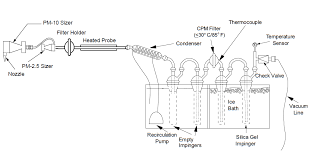EPA Methods m 02a
Particulate matter (PM) is one of the six common air pollutants that the U.S. Environmental Protection Agency (EPA) sets National Ambient Air Quality Standards for as required under the Clean Air Act. Historically, EPA first regulated total suspended particulate (TSP), followed by PM that is less than 10 micrometers in diameter (PM10), which is inhalable and harmful to human health, and then particulate matter less than or equal to 2.5 micrometers in diameter (PM2.5).
The PM2.5 particulate matter consists of both filterable PM and condensable particulate matter (CPM). Method 201A collects filterable PM using a filter and a set of cyclones to separate the PM10 and PM2.5 from larger sized particles. Method 202 uses a condenser, dry impingers, and a filter to collect CPM. CPM is not captured by a filter at stack conditions, but forms solid or liquid particulate matter immediately after discharge from the stack. Method 202 is combined with Method 201A or other filterable PM methods for source testing.

There are no products listed under this category.